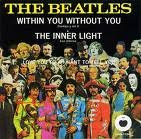
"Sgt. Pepper's Lonely Hearts Club Band" was released in the UK in mono and stereo on Parlophone June 01 1967 (although there are claims tha the album was released on May 16 1967 depending on who you read).
The next piece of music to be officially released by The Beatles was a single 45 around the world. It was the summer of love and the purpose of the single was to enlighten the world with their special message of Love. ( It also helped that the single was released around the world almost exclusively at number one thereby making The Beatles and their related companies a lot of money). The single was "All You Need Is Love/ Baby, You're A Rich Man".
The next tune we'll be looking at is an original composition by Lennon/McCartney written mainly by John entitled "All You Need Is Love".
The song was originally commissioned for a live satelitte television special in which the Beatles would appear to represent the BBC and perform their latest single. There were a couple of song in contention (It's been said the "You're Mother Should Know" was also in the running) before selecting John's "All You Need Is Love".
The basic track for the song was recorded Wednesday June 14 1978 at Olympic Sound Studios in Barnes, England at Studio one. There were 33 takes in all of the following instrumentation: Paul playing the double bass, John playing the harpsichord, George scratching a violin and Ringo on drums. Take 10 was chosen as best and a four track tape reduction was made at this point.
Five days later back at EMI studio three on June 19 1967, John added lead vocals and the backing vocals by the other Beatles was also recorded. On one track: added drums, a piano (by George Martin) was added to the basic track as well.
Two days later on June 21 1967 from EMI room 53, the basic track was mixed in mono twice. The first mix was kept in-house, while the second mix was given to the director of the BBC for reference via the upcoming television appearance by The Beatles.
Two days after that, the orchestra entered the studio (EMI studio one) on June 23 1967 and nine takes of the orchestra taped rehearsal was completed onto take 10. The same musicians on this overdub also appeared in the television broadcast.
On June 24 1967, one day before the event, there were more rehearsals with the orchestra. Four takes were rehearsed and taped.
Finally, on June 25 1967, the Beatles and the orchestra and family and friends all gathered at EMI studio one for the big event. There were three rehearsal takes (with orchestra and vocal) and four-track to four-track recording takes 51 to 58 (take 58 being the commercial version). As you can see , most of the rhythm track had already been previously recorded. The only "live" recording as witnessed on the television broadcast are: John Lennon's lead vocals (the backing vocals were mimed by Paul and George), Paul's Rickenbaker bass , George's Fender electric guitar and Ringo's drums. Once the televised signal was completed and the orchestra left, John Lennon attempted to fix some of his vocal. Ringo added the snare drum roll at the beginning of the song as an overdub.
"All You Need Is Love" was mixed for mono on June 26 1967 from the control room of EMI studio two. Nine mixes were attempted with remix four being deemed at "best". The commercial released single contains this mix.
"All You Need Is Love" was once again mixed for mono on November 01 1967 due to preparation for the "Yellow Submarine" animated film. This mix (11) was used in the original film.
Finally, "All You Need Is Love" was mixed for stereo on October 29 1968 from the control room of EMI studio three. The reason for the stereo mix was due to the inclusion of the song on the "Yellow Submarine" soundtrack. There is also a stereo mix which was conducted in the nineties whereby the vocals and orchestra tracks have been re-positioned in the stereo spectrum and this unique mix was used on the "Yellow Submarine Songtrack".
"All You Need Is Love" was originally released as the single on Parlophone R 5620 on July 07 1967 and released as the single on Capitol 5964 on ten days later on July 17 1967. The song can be found on the Capitol LP/CD "Magical Mystery Tour" as well as the Apple LP/CD "Yellow Submarine" and the Apple compilation "The Beatles 1967-1970". This song is also featured on the Theatre Projects Record UK LP "All You Need Is Love - The Story of Popular Music" as well as the EMI/Capitol compilation LP "Reel Music". It is also included on the UK and North American version of the EMI/Capitol LP "20 Greatest Hits" and the EMI/Apple/Capitol 2-LP/CD "1", the Apple/EMI/Capitol LP/CD "Yellow Submarine Soundtrack" as well as the EMI/Apple/Capitol 2-LP/CD "Love".












